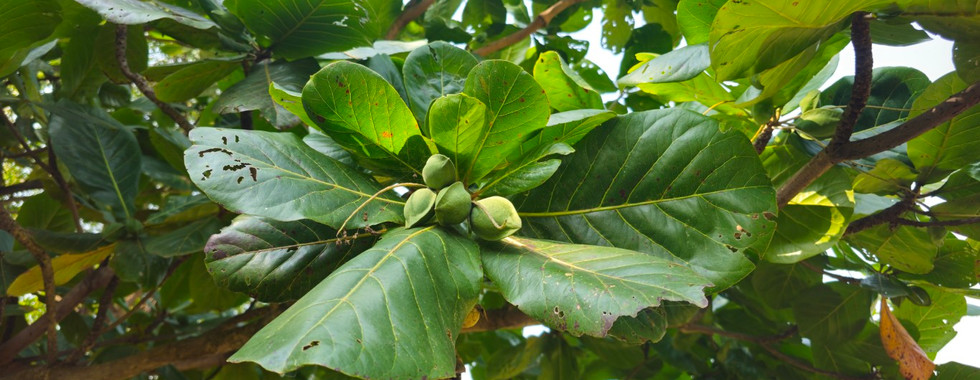Terminalia catappa(Combretaceae) Indian Almond
- Das K

- Nov 11
- 7 min read
Terminalia catappa (Indian Almond)
1. Scientific name and Basic Taxonomic classification
Species: Terminalia catappa
Family: Combretaceae
Genus: Terminalia
Related Herbs from the same family:
Terminalia chebula (Haritaki): The "King of Medicines" in Ayurveda, a fundamental Triphala fruit used as a Rasayana (rejuvenative), digestive, and tridoshic balancer, especially for Vata.
Terminalia bellirica (Bibhitaki): Another key component of Triphala, used primarily for Kapha disorders, respiratory health, and as a hair tonic.
Terminalia arjuna (Arjuna): A premier cardioprotective and heart tonic herb, used for strengthening the heart muscle, managing cholesterol, and healing wounds.
Combretum indicum (Rangoon Creeper): The seeds are used in traditional medicine as an anthelmintic (deworming agent).
The Combretaceae family is of immense importance in Ayurveda and traditional medicine, particularly the Terminalia genus, which provides some of the most celebrated Rasayana and therapeutic plants.
2. Common names
Scientific Name: Terminalia catappa | English: Indian Almond, Tropical Almond, Country Almond | Sanskrit: Taapas-taru, Ingudi | Hindi: Jangli Badam, Desi Badam | Tamil: Nattuvadumai, Vadukappu | Telugu: Badam Chettu | Kannada: Kadu Badami | Malayalam: Aat-ngottapalam, Thaalikkottai | Marathi: Jangli Badam | Bengali: Kath Badam | Gujarati: Desi Badam | Sinhala: Kottamba | Filipino: Talisay | Spanish: Almendro de los trópicos | French: Badamier |
3. Medicinal Uses:Antioxidant, Hepatoprotective (liver-protecting), Anti-inflammatory, Antipyretic (fever-reducing), Antidiabetic, Antihypertensive, Antifungal, Astringent, Demulcent.
Medicinal Parts:The leaves, bark, fruit (kernel), and young shoots are all used for medicinal purposes.
4. Phytochemicals specific to the plant and their action.
Tannins (Punicalin, Punicalagin): Hydrolyzable tannins found abundantly in the leaves. Their actions are potent Antioxidant, Antihypertensive, and Hepatoprotective.
Flavonoids (Quercetin, Kaempferol): Plant-based antioxidants. Their actions are Anti-inflammatory, Antioxidant, and Antidiabetic (improving insulin sensitivity).
Triterpenoids (Ursolic Acid, Asiatic Acid): Compounds with a wide range of biological activities. Their actions are Anti-inflammatory, Hepatoprotective, and Anticancer (cytotoxic to cancer cells).
Phytosterols (Beta-Sitosterol): A plant sterol. Its actions are Anti-inflammatory and Hypolipidemic (cholesterol-lowering).
Saponins: Contribute to the Antifungal and Anti-inflammatory properties of the plant.
5. Traditional and Ethnobotanical uses covering the Medicinal uses.
Yakrit Vikara (Liver Disorders) & Kamala (Jaundice)
Formulation: Leaf decoction.
Preparation & Use: A decoction of the leaves is consumed regularly to treat liver disorders like jaundice, hepatitis, and to generally protect the liver from damage.
Reasoning: The potent antioxidants, particularly punicalagin, protect liver cells (hepatocytes) from toxin-induced damage and help in regeneration, supporting the liver's detoxification role.
Jwara (Fever) & Daha (Burning Sensation)
Formulation: Bark decoction or leaf infusion.
Preparation & Use: The bark or leaves are boiled in water, and the decoction is drunk to reduce fevers and alleviate internal heat and burning sensations.
Reasoning: Its Sheeta (cooling) potency and antipyretic properties help pacify Pitta dosha, which is responsible for fever and burning.
Vrana (Wounds) & Twak Roga (Skin Diseases)
Formulation: Leaf paste or bark decoction wash.
Preparation & Use: A paste of the fresh leaves is applied topically to wounds, skin rashes, and inflammatory skin conditions like dermatitis. A decoction is used as a wash for skin infections.
Reasoning: The astringent (due to tannins) and anti-inflammatory properties help reduce swelling, tighten tissues, and promote healing.
Hridroga (Heart Disease) & Raktachaapa (Hypertension)
Formulation: Leaf tea or decoction.
Preparation & Use: Drinking a tea made from the leaves is a traditional practice for supporting heart health and managing high blood pressure.
Reasoning: The flavonoids and tannins have been shown to have vasorelaxant effects, helping to dilate blood vessels and reduce blood pressure. Their antioxidant action also protects blood vessels from damage.
Prameha (Diabetes)
Formulation: Leaf decoction.
Preparation & Use: The leaf decoction is taken regularly to help lower blood sugar levels.
Reasoning: Compounds in the leaves improve glucose uptake and insulin sensitivity, contributing to a hypoglycemic effect.
6. Healing recipes, Teas, Decoctions and Culinary use (if any):
The kernel (seed) inside the fruit is edible and tastes similar to almond, often eaten raw or roasted. The young shoots are sometimes used in salads.
Hepatoprotective Leaf Decoction
Purpose: To support liver function and treat jaundice.
Preparation & Use:
Take 5-10 fresh or dried Terminalia catappa leaves.
Boil in two cups of water until it reduces to one cup.
Strain and drink once a day.
Skin Healing Leaf Paste
Purpose: To treat wounds, rashes, and skin inflammation.
Preparation & Use:
Grind a handful of fresh leaves with a little water to make a paste.
Apply directly to the affected area and leave for 30 minutes before rinsing.
Hypertension and Heart Health Tea
Purpose: To support cardiovascular health.
Preparation & Use:
Crush 2-3 dried leaves.
Steep in a cup of hot water for 10 minutes.
Strain and drink once daily.
Edible Kernels (Desi Badam)
Purpose: As a nutritious snack.
Preparation & Use:
Crack the hard shell of the dried fruit to extract the kernel.
Eat raw or lightly roast with salt or ghee.
--
7. In-Depth Phytochemical Profile and Clinical Significance of Terminalia catappa
Introduction
Terminalia catappa, while it produces an edible nut, its profound medicinal value lies in its leaves, bark, and fruit skin. Unlike the aromatic herbs previously detailed, T. catappa' therapeutic power is derived predominantly from a massive and diverse reservoir of hydrolyzable tannins, flavonoids, and triterpenoids. It is a cornerstone in ethnomedicine for its broad-spectrum anti-inflammatory, hepatoprotective, and antimicrobial properties.
1. Phenolic Compounds (The Primary Therapeutic Class)
Key Compounds:The phytochemistry of T. catappa is dominated by potent phenolic compounds, particularly hydrolyzable tannins.
Punicalagin: A massive ellagitannin, often the most abundant and bioactive compound in the leaves.
Punicalin: A precursor or derivative of punicalagin.
Flavonoids: Quercetin, Kaempferol, Vitexin, Isovitexin, Luteolin.
Other Tannins & Phenolic Acids: Gallic acid, Ellagic acid, Corilagin, Chebulagic acid, Geraniin.
Actions and Clinical Relevance:This rich phenolic profile is responsible for the plant's most celebrated effects.
Potent Antioxidant: Punicalagin and other ellagitannins are among the most powerful natural antioxidants known. They effectively scavenge free radicals, chelate metal ions, and boost endogenous antioxidant systems like glutathione. This makes T. catappa extracts highly effective in combating oxidative stress-related tissue damage.
Anti-inflammatory & Analgesic: The compounds, particularly punicalagin and flavonoids, potently inhibit key inflammatory pathways, including the NF-κB signaling cascade and enzymes like cyclooxygenase (COX) and lipoxygenase (LOX). This results in significant reduction of inflammation and pain, supporting its use in treating arthritis, gastritis, and general inflammatory conditions.
Hepatoprotective (Liver Protection): This is a hallmark activity. The antioxidants protect hepatocytes from toxins (e.g., carbon tetrachloride, paracetamol overdose) by reducing lipid peroxidation and enhancing liver regeneration. It is a well-documented traditional remedy for jaundice and liver disorders.
2. Triterpenoids
Key Compounds:
Pentacyclic Triterpenes: Ursolic acid, Asiatic acid, Oleanolic acid, Arjunolic acid.
Other Triterpenoids: β-Sitosterol (a phytosterol), Stigmasterol.
Actions and Clinical Relevance:Triterpenoids add a crucial layer of therapeutic activity, often synergizing with the phenolics.
Anti-inflammatory & Wound Healing: Ursolic acid and asiatic acid have strong anti-inflammatory properties and promote wound contraction and collagen synthesis. This makes T. catappa an excellent topical agent for ulcers, burns, and skin repair.
Hepatoprotective (Synergy): Triterpenes like arjunolic acid contribute significantly to the hepatoprotective effect by stabilizing hepatocyte membranes and exhibiting anti-fibrotic activity.
Antidiabetic Potential: Ursolic acid and oleanolic acid are known to enhance insulin sensitivity and glucose uptake, supporting the traditional use of the plant in managing diabetes.
3. Other Critical Compounds
Key Compounds:
Fatty Acids (in Kernels): Oleic acid, Palmitic acid, Linoleic acid. The kernel oil is nutritionally similar to sweet almond oil.
Carotenoids: β-carotene, Lutein.
Miscellaneous: Saponins, Tannins (condensed type).
Actions and Clinical Relevance:
Emollient & Cosmetic Use: The fixed oil from the kernels is rich in oleic acid, making it a excellent skin emollient, used in cosmetics and for soothing dry skin.
Nutritional Value: The kernels are edible, nutritious, and a source of healthy fats and protein.
Adjunctive Activities: Carotenoids contribute to antioxidant capacity, while saponins may contribute to the antimicrobial and mild expectorant properties.
An Integrated View of Healing in Terminalia catappa
The healing power of Terminalia catappa is a perfect demonstration of phytochemical synergy, primarily driven by its complex phenolic-triterpenoid matrix.
For Hepatoprotection and Detoxification: This is a multi-targeted action. The Hydrolyzable Tannins (Punicalagin) provide a powerful antioxidant shield for liver cells, directly neutralizing toxins and preventing lipid peroxidation. Simultaneously, Triterpenoids (Ursolic acid, Arjunolic acid) work by stabilizing cell membranes and reducing inflammation within the liver. This synergistic protection promotes hepatocyte survival and regeneration, making it a comprehensive liver tonic.
For Anti-inflammatory and Analgesic Effects: The plant attacks inflammation from multiple angles. Punicalagin inhibits the master regulator of inflammation, NF-κB, thereby reducing the production of cytokines like TNF-α and IL-6. Meanwhile, Flavonoids (Quercetin) and Triterpenoids (Ursolic acid) inhibit the enzymes (COX-2) that produce prostaglandins, the direct mediators of pain and swelling. This makes it effective for both systemic and topical inflammatory conditions.
For Dermatological Health and Wound Care: The leaves are a traditional poultice for wounds and skin diseases. Here, the Tannins act as astringents, precipitating proteins to form a protective layer and reduce secretions. The anti-inflammatory actions of punicalagin and ursolic acid reduce redness and swelling, while the antioxidant compounds protect the nascent tissue from oxidative damage. The triterpenoids further stimulate collagen deposition and wound contraction, accelerating healing.
As a Functional Food and Tonic: From the nutritious kernels to the medicinally potent leaves, the tree offers a spectrum of benefits. The daily consumption of leaf infusions acts as a preventive antioxidant and anti-inflammatory tonic, potentially mitigating the risk of chronic diseases, while the kernel oil provides nutritional and topical benefits. Its use in aquaculture to improve fish health and color further underscores its systemic bioactive potential.
Disclaimer:
Terminalia catappa is generally safe when used in traditional preparations. The leaves and bark have a significant tannin content, so excessive consumption may cause stomach upset or constipation in sensitive individuals. The kernels are safe to eat. As with any herb used for therapeutic purposes, especially for conditions like diabetes and hypertension, it is important to consult with a healthcare provider as it may interact with medications. This information is for educational purposes only and is not a substitute for professional medical advice.
8. Reference Books, Books for In-depth Study:
Indian Medicinal Plants by K.R. Kirtikar and B.D. Basu
Indian Materia Medica by Dr. K.M. Nadkarni
Ayurvedic Pharmacopoeia of India
The Wealth of India
9. Further study: Plants that might interest you due to similar medicinal properties
1. Terminalia arjuna (Arjuna)* Species: Terminalia arjuna | Family: Combretaceae | Genus: Terminalia* Similarities: Both are from the same genus and are powerhouse herbs for cardiovascular health. While Arjuna is more specific for heart muscle strength, T. catappa shares antihypertensive and antioxidant properties that protect the heart and blood vessels.
2. Phyllanthus emblica (Amla/Indian Gooseberry)* Species: Phyllanthus emblica | Family: Phyllanthaceae | Genus: Phyllanthus* Similarities: Both are exceptionally high in antioxidants and are potent hepatoprotective (liver-protecting) agents. They are also used for their cooling (Sheeta) properties to pacify Pitta, reduce fever, and are beneficial in diabetes management.
3. Punica granatum (Pomegranate/Anar)* Species: Punica granatum | Family: Lythraceae | Genus: Punica* Similarities: Both contain punicalagin-type tannins, which are responsible for potent antioxidant and antihypertensive effects. They are both considered "cooling" fruits in traditional medicine and are used for heart health and inflammation.
-x-x-x-End-x-x-x-





















Comments